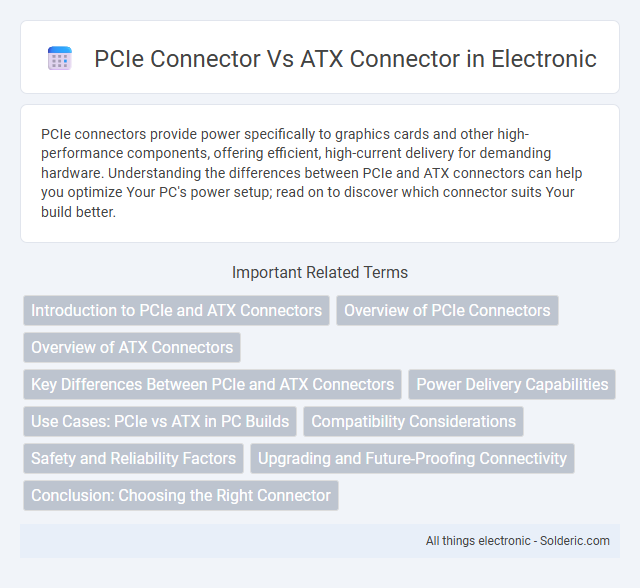PCIe connectors provide power specifically to graphics cards and other high-performance components, offering efficient, high-current delivery for demanding hardware. Understanding the differences between PCIe and ATX connectors can help you optimize Your PC's power setup; read on to discover which connector suits Your build better.
Comparison Table
| Feature | PCIe Connector | ATX Connector |
|---|---|---|
| Purpose | Provides power to PCIe devices like GPUs | Supplies power to motherboard and CPU |
| Pin Count | 6 or 8 pins | 20, 24 pins (main power) |
| Connector Type | 6+2 pin modular design | Large main power connector |
| Power Delivery | Up to 150W (8-pin) | Up to 300W+ to motherboard |
| Use Case | Graphics cards, expansion cards | Motherboard, CPU power supply |
| Voltage Rails | 12V only | Multiple voltages: 3.3V, 5V, 12V |
| Standard | PCI Express power connector | ATX power supply specification |
| Compatibility | PCIe slots and devices | Motherboards from various manufacturers |
Introduction to PCIe and ATX Connectors
PCIe connectors serve as high-speed interfaces that deliver power and data transfer between the motherboard and graphics cards or other expansion cards, ensuring optimal performance for gaming and professional applications. ATX connectors primarily supply power from the power supply unit to the motherboard, supporting various voltage rails essential for stable system operation. Understanding the differences between PCIe and ATX connectors helps you optimize your computer's hardware compatibility and power distribution.
Overview of PCIe Connectors
PCIe connectors serve as high-speed interfaces on motherboards, enabling direct communication between the CPU and expansion cards like GPUs, providing data transfer rates up to 32 GT/s in PCIe 4.0 and higher versions. These connectors come in various lane configurations, including x1, x4, x8, and x16, with the x16 variant commonly used for graphics cards to maximize bandwidth. Unlike ATX connectors, which primarily supply power to the motherboard and components, PCIe connectors are designed for data transmission and device expansion, playing a critical role in system performance and scalability.
Overview of ATX Connectors
ATX connectors serve as the main power interface on motherboards, providing essential electrical connections for the CPU, memory, and peripheral components. These connectors come in various pin configurations, such as 20-pin or 24-pin, designed to deliver different voltage rails and ensure stable system operation. Understanding your ATX connector type is crucial for compatibility with power supply units and overall system performance.
Key Differences Between PCIe and ATX Connectors
PCIe connectors provide dedicated power directly to graphics cards and other high-performance peripherals, supporting 6-pin, 8-pin, or combined configurations with up to 150W per connector, while ATX connectors primarily supply power to the motherboard with 20-pin or 24-pin main connectors delivering up to 300W. PCIe connectors are designed for peripheral-specific power stability and efficiency, whereas ATX connectors distribute power across multiple motherboard components including CPU, RAM, and chipset. The physical design of PCIe connectors is compact and cable-specific to GPUs, contrasting with the larger, multi-pin ATX motherboard connectors essential for overall system power management.
Power Delivery Capabilities
PCIe connectors are specifically designed to provide additional power to high-performance graphics cards, delivering up to 300 watts via 8-pin connectors, ensuring stable power supply for demanding GPU workloads. ATX connectors, primarily the 24-pin main power connector, supply power to the motherboard and support a range of voltages, but are not tailored for high-current components like GPUs. PCIe connectors complement the ATX power by delivering targeted power directly to expansion cards, enabling efficient and reliable power delivery crucial for gaming and professional applications.
Use Cases: PCIe vs ATX in PC Builds
PCIe connectors primarily power high-performance components like graphics cards and NVMe SSDs, ensuring stable, high-bandwidth connections for gaming and professional workstations. ATX connectors supply power to the motherboard and essential components such as the CPU and memory modules, maintaining system-wide stability and functionality. Your PC build benefits from correctly using PCIe connectors for expansion cards and ATX connectors for core power delivery to achieve optimal performance and reliability.
Compatibility Considerations
PCIe connectors are designed primarily for high-speed data transfer between the motherboard and expansion cards such as GPUs, requiring specific slot types and pin configurations for proper function. ATX connectors, on the other hand, supply power to the motherboard and come in standardized 20-pin or 24-pin formats, necessitating compatibility with the motherboard's power socket. Ensuring compatibility involves verifying that the power supply's ATX connector matches the motherboard's power header and that PCIe connectors correspond to the GPU or expansion card specifications to prevent hardware damage and ensure optimal performance.
Safety and Reliability Factors
PCIe connectors feature robust locking mechanisms and gold-plated contacts that enhance safety by preventing accidental disconnections and ensuring consistent electrical conductivity under high current loads. ATX connectors offer multiple pin configurations designed to distribute power evenly, reducing the risk of overheating and enhancing system reliability during prolonged use. Understanding these safety and reliability differences helps you select the right connector for stable and secure system performance.
Upgrading and Future-Proofing Connectivity
PCIe connectors provide higher data transfer speeds and increased lane configurations compared to ATX connectors, making them essential for upgrading graphics cards and expansion cards. Future-proofing connectivity is achieved through PCIe's scalable architecture, supporting newer versions like PCIe 5.0 and 6.0 with backward compatibility, whereas ATX connectors mainly supply power without impacting data throughput. Choosing PCIe connectors ensures better performance and compatibility for evolving hardware demands in gaming, AI, and high-speed computing applications.
Conclusion: Choosing the Right Connector
Choosing the right connector depends on your power needs and compatibility requirements; PCIe connectors are designed to deliver high power to graphic cards, while ATX connectors primarily power the motherboard and other components. Understanding your system's power distribution helps ensure stable performance and prevents hardware damage. Your choice between PCIe and ATX connectors impacts overall system efficiency and reliability.
PCIe Connector vs ATX Connector Infographic

 solderic.com
solderic.com